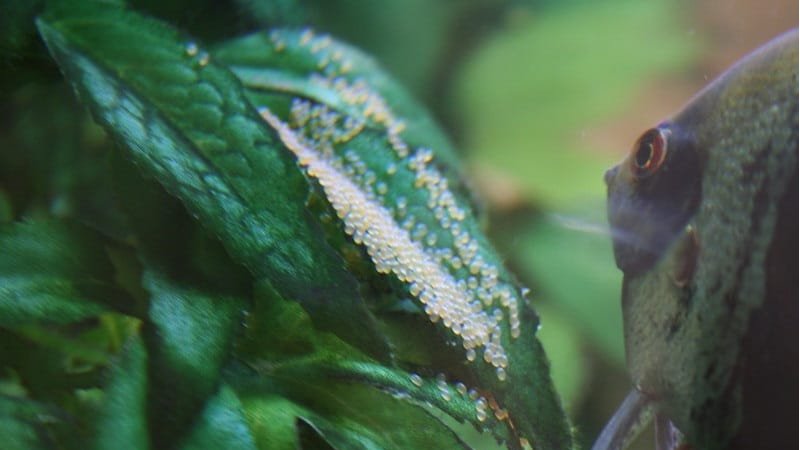According to the International Journal of Veterinary Science and Medicine, Fungus Saprolegnia parasitica is one of the most common fungi to attack angelfish eggs. This fungus belongs to the cotton mold genus, which has a fluffy white appearance. Due to easy access to dead cells and fish waste, fungus thrives in fish tanks like most water molds. Since eggs are vulnerable, they are an easy target for fungus.
It is a very bad sign when you notice your angelfish eggs turning white. The issue isn’t a natural part of the growing process nor a minor issue. The egg has been engulfed by fungus and is dead. The fungus will destroy your entire stack of angelfish eggs if allowed to spread.
To deal with them, I think you should know clearly about fungus. In this article, I will provide you with essential knowledge about angelfish eggs fungus, including How they harm your angelfish eggs, treatment, and prevention.
Related Articles:
- How To Tell If Angelfish Eggs Are Fertilized?
- Why Are Angelfish Eggs Turning White? 5 Best Ways To Avoid
- Angelfish Laying Eggs: 6 Important Things You Need To Know
- 10 Notes And Guide On Hatching Angelfish Eggs Artificially
- Will Angelfish Lay Eggs Without Male? How It Affect The Eggs
- All About Angelfish Eggs: Stages, How To Care, How They Look
- Pregnant Angelfish Behavior: Clearest Signs That Indicate Spawning
How Does Fungus Affect Your Angelfish Eggs?
Angelfish eggs are small and round, with a soft amber color when they are first laid. When they suddenly become white in your aquarium, you might wonder if this is normal. This means that the egg has been infected by fungus and, consequently, has now died. Sadly, there is no way for the egg to be recovered or reversed.
There are multiple reasons why angelfish eggs can become infected with fungus, but the most common reason is:
- As a result of not being fertilized, the eggs have gone bad and are now rotting, attracting fungal growth.
- You have fungal spores in your tank, and they have attached themselves to an egg that was weak because of genetic issues or had a thin shell.
- As a result of your tank being overrun by fungus, there is no chance that the angelfish eggs will survive.
As soon as the fungal spores come in contact with the egg, they can penetrate the shell. The parasites will burrow deep into the inner yolk of the egg and destroy it, spreading further until they consume the entire egg as a whole. As a result, the whole egg will turn white or fluffy. The fungus can spread rapidly from one egg to another; essentially, the first egg will act as a basecamp for infecting surrounding, healthy eggs.
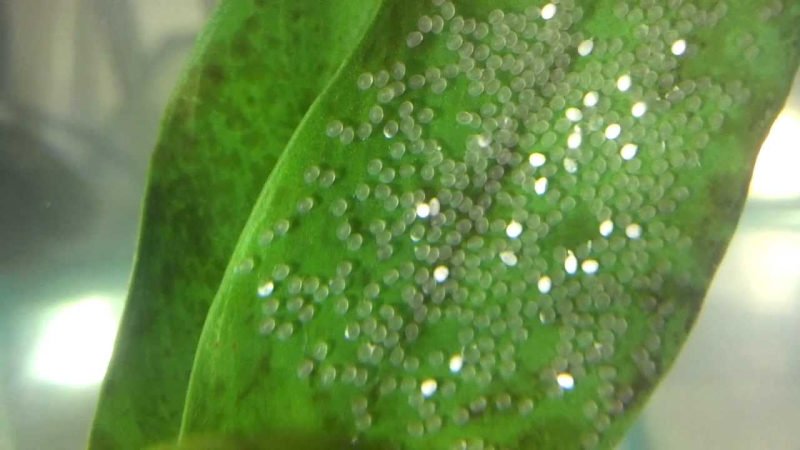
Within a short period of time, it is easy to have all your angelfish eggs turn white and dead. It is therefore very important that you keep watch over your angelfish eggs. If you notice the slightest sign of whiteness in your eggs, you should take immediate action.
How To Stop Fungus Growing On Angelfish Eggs?
A breeding tank that has cloudy water is a sure sign of fungus growth. Soon it will thicken around the clutch of eggs. If, however, the spores do not yet appear to be out of control, there may be very few signs that angelfish eggs are at risk.
It doesn’t matter what the problem is, the solution is the same. You can keep the fungus at bay by doing the following:
Cleaning The Tank
A direct approach involves changing the water in the fish tank so that the spores are removed. Don’t change more than 30% of the water at once. Otherwise, you might shock the fish and the eggs.
You should also clean your aquarium thoroughly. You should clean the walls, clean the sediment, rock on the bottom, and clean the decorations. Fungus is most likely to grow wherever it finds a food source. Generally, this will include the bottom of the aquarium, decorations, and around the filter.
Therefore, be sure to change the filters, clean the unit thoroughly, and remove any spores found. The filter may have already attempted to remove the fungus. Even so, if it was overwhelmed, it may have reintroduced the leftover spores back into the water.
Changing Tank Water Regularly
Because you cannot change more than 30 percent of the water at once (without putting your fish at risk), keep up the routine of cleaning the tank.
- Do a 25-30% water change once a week.
- Or you can try to change 10% of the water every 2-3 days.
- If the situation is dire, you can change 5% of the water daily.
It is important to understand that cleaning the tank every day could cause the adult angelfish to get stressed out, which may cause them to eat the eggs. Likewise, if you do not change the water carefully, the water’s chemical balance isn’t maintained, and the changes to the water’s conditions can lead to the eggs dying themselves.
While drastic changes could eliminate the fungus before it’s too late, they may also cause damage.
Removing Diseased Eggs
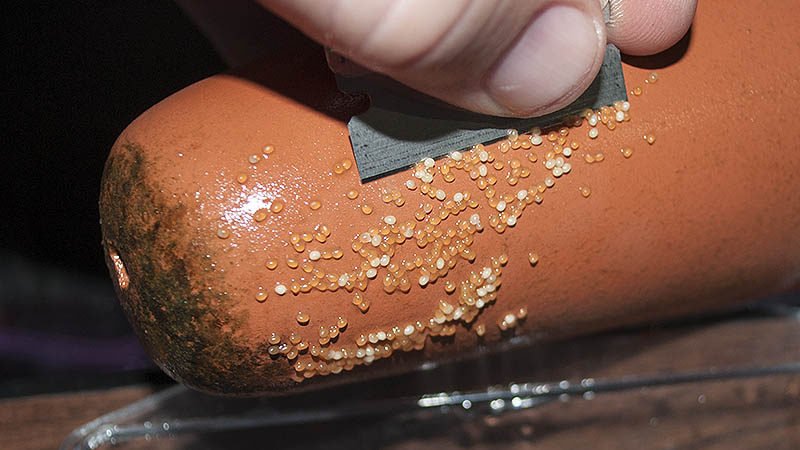
In order to avoid the transmission of disease to other eggs, it is imperative to remove any dead eggs before they become infected. Angelfish lay their eggs in clutches, so you must pick out the white ones carefully. If you use your hands, a pen, or any other object to do this, you may damage others. Instead, I recommend using these tools:
A Fish Tank Pipette
The fish pipette can be considered as the smaller version of the turkey baster. They are available at pet stores. But it is also possible to use actual turkey basters to remove the fungus-coated angelfish eggs. If the nozzle is too wide, you risk damaging other eggs, so make sure the nozzle is narrow enough.
Tweezers
There is more room for error, but it is also a more accessible tool, making it easier for people to use. Dip your hand into the tank with tweezers and squeeze the diseased egg gently
You need to be very careful as angelfish eggs are very fragile. A lot of pressure may crush the egg, causing fungal spores to spread or damaging other eggs in the water.
Try to wiggle the egg back and forth a couple of times until it becomes loose. Afterward, you can gently remove it from the tank at a slow pace and dispose of it as you wish.
A Needle
You can also use a needle to loosen the white eggs with a bit of care gently. Using the fine tip of the needle, gently poke the edges and undersides of the dead egg. If it does not seem to be moving at all, poke at it from multiple angles so that it will lift cleanly. Once it’s free, it can be removed by hand or with the help of tweezers.
Angelfish Eggs Fungus Treatment
The only way to completely eliminate fungus is to use a chemical treatment. These treatments can come from a professional medication or home remedies.
After you have cleaned the tank and removed the diseased eggs, you should consider the treatments. This is going to ensure that any remaining spores are killed off, and you will be able to keep your angelfish eggs safe.
Methylene Blue
Methylene blue is one of the most popular treatments used to treat and prevent fungus from growing on eggs and fry. Also known as methylthioninium chloride, its purpose is to destroy parasitic and fungal infections without harming the fish themselves. Additionally, it is also safe for use with other aquatic animals.
Many fish keepers use this product in the course of cycling their tanks. It provides the fungus with no chance to develop. It will not upset the chemical balance of your tank as long as you follow the instructions carefully. You just have to handle it with care since it can stain anything that comes in contact with it.
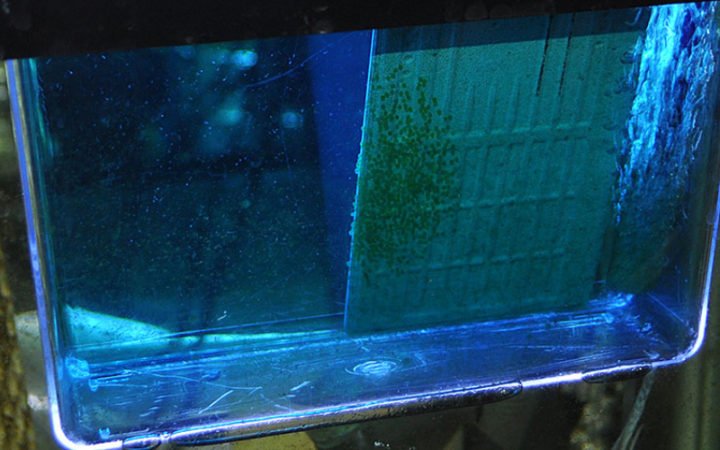
- For every 10 gallons of water, use 1 teaspoon of methylene blue.
- Add an extra 1/3 teaspoon per 10 gallons for higher concentrations.
- It only needs to be applied once.
Acriflavine
The second most popular antifungal chemical that is used to remove growth is Acriflavine. It was originally used as an antiseptic but can still be applied as a topical treatment. Nevertheless, its main purpose is to act as a fungicide, which is safe for aquariums and angelfish eggs simultaneously.
When treating the tank, the parents angelfish do not need to be removed. The solution can be applied directly to the tank, following the instructions.
Hydrogen Peroxide
Hydrogen peroxide is a colorless liquid that can help you treat fungus by breaking down the spores’ molecules and killing them. Some aquarium owners claim that Hydrogen peroxide helps disinfect eggs and may even prevent newly infected (but not yet dead) eggs from being overtaken.
As long as you proceed with caution, hydrogen peroxide is a safe fungicide for your aquariums. However, the effects will vary according to the fish species and the aquarium’s conditions.
The effects are more pronounced in larger fish. If the aquarium temperature is particularly high, the peroxide may become slightly toxic. Angelfish do like slightly warm water, so you may want to consider other options if your species prefers a higher range.
Potassium Permanganate
You can use potassium permanganate to destroy the bacteria, fungi, and parasites that are growing in the aquarium. However, the use of potassium permanganate should be done carefully. A high dose of this can be fatal to all your fish, including the eggs. Be sure to follow the instructions closely.
Iodine
Povidone iodine is an effective way to treat a fungus that has infected the angelfish eggs due to its antibacterial and antifungal properties. It doesn’t harm the eggs in any way, so you can apply it several times to them, or spread it around them without harm. You can do this when you’re treating a newly infected tank and want to ensure that your clutch is protected.
You should, however, dose this carefully. When applied in high doses, iodine is toxic. 0.006ppm is the maximum safe level for aquarium fish. When treating your aquarium, always test its iodine levels with a test kit.
Rosemary Extract
Rosemary extract can extend the lifespan of fish eggs. Besides helping them develop, it also prevents fungus infections and fortifies them against future spores.
In the study, rosemary extract was compared to some other treatments like methylene blue, iodine, potassium permanganate as well as other medicinal herbs. It had the most significant impact on decreasing bacteria and increasing the hatching rate of eggs.
Angelfish Eggs Fungus Prevention
Once you’ve gone through the trouble of treating the fungus in your angelfish tank, you’re likely to worry that it’ll return. The good news is that there are ways to protect your tank (and your eggs) from further outbreaks of fungal infection.
Keep The Parents Present
Often, owners decide to separate the eggs from the clutch as new angelfish parents are notorious for eating their eggs. However, the parents can also play a significant role in preventing fungus from growing in the eggs.
During the spawning process, both the female and male angelfish will pick away at the spores, eating any fungus growth before they take hold. Experimented breeding pairs are unlikely to eat eggs. If you are confident they are trustworthy, you can let them handle the job.
Good Egg Location
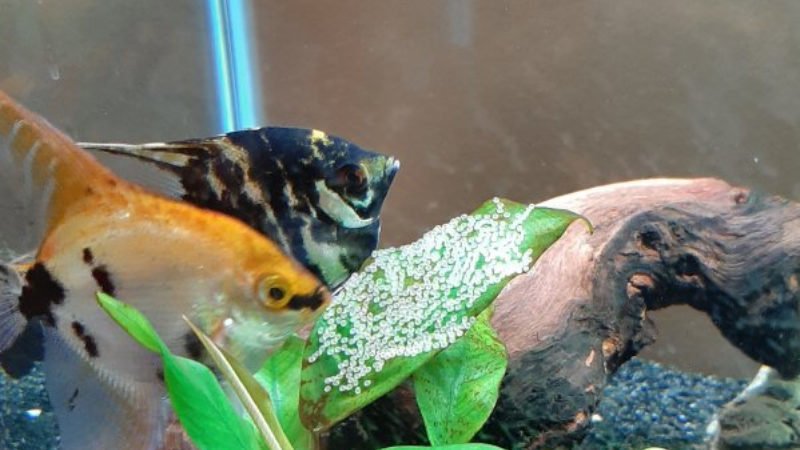
It is very important to place the eggs in your aquarium in an appropriate place. In fast-moving water, eggs are less likely to become fertilized.
Angelfish sperm will be deposited onto the clutch of eggs by males, but heavy filters may be able to wash this away before it has a chance to make contact with the eggs. As a result, unfertilized eggs will remain in place and start to rot.
Likewise, the eggs may also be swept away by too-fast currents. As a result, they may be damaged or placed in a more vulnerable position in the tank, increasing the probability of fungus growing on them. As a result, you should ensure that the eggs are laid in a safe area such as a spawning plate, plants, or a docile corner of the tank.
Ideal Water Temperatures
Your angelfish should be kept in a tank where the water temperature does not exceed 84 degrees F. The higher the water temperature, the lower the oxygen levels will be in the tank. In this case, fungus growth and death of the unhatched eggs are more likely to occur.
Correct Water pH Levels
The eggs will become compromised if the pH levels are not kept within the proper range. As they get weaker or even dead, fungus becomes a serious problem much sooner.
Angelfish prefer soft, acidic waters. You should pay attention to what species you have and set the levels based on their preferences, especially for the breeding tank.
Correct Water pH Levels
If you want to prevent and treat fungus on angelfish eggs, it is fundamental that your aquarium is well-kept. The best way to avoid fungal growth in your tank is to ensure it is well-balanced, clean, and treated adequately.
Video About Preventing Fish Egg Fungus
FAQs
Why do angelfish eggs turn white?
It is a huge red flag when angelfish eggs turn white. When angelfish eggs turn from translucent-amber to opaque white, you must act quickly to preserve as many as possible. An opaque-white color in the eggs indicates that a fungal infection has infected the eggs.
Will fungus attack viable eggs?
The fungus will not attack viable eggs, but it will grow inside and around unfertilized eggs, making it very difficult for the wigglers to get out, and these will die due to the fungus.
Are the angelfish parents eating their eggs that have fungus?
While it is unclear how angelfish are able to differentiate between ones in which the eggs are sick and ones in which they are not, they do seem to be aware of the presence of unhealthy eggs.
The eggs that have fungus—usually those that have not been fertilized—are usually eaten by them. This may be a method for the angelfish to prevent the fungus spread to the other eggs.
Conclusion
Fungus growth is truly bad for your angelfish eggs. It can cause the eggs to turn white and die.
You will be able to see the new fish spring to life when you have completed all the steps and made the necessary adjustments. Since you know what to do as well, you should find it easier to prevent angelfish fungus issues in the future.

Annette M. Chaney is an experienced marine biologist with over 20 years of experience as an aquarist and fishkeeper. She started her first aquarium at a young age, filling it with frogs and goldfish obtained from the ten-cent pet store.
Annette grew up caring for and breeding African Cichlids, which led to a hobby in high school that doubled as a profitable means. Attending Reed College gave her time to solidify herself as an accomplished aquarium caretaker with an eye for sales. After that, from 2009 – 2013, she studied at Roger Williams University – one of the most prestigious universities for Aquaculture and Aquarium in USA. She is the founder of AquariumCircle since 2010.
